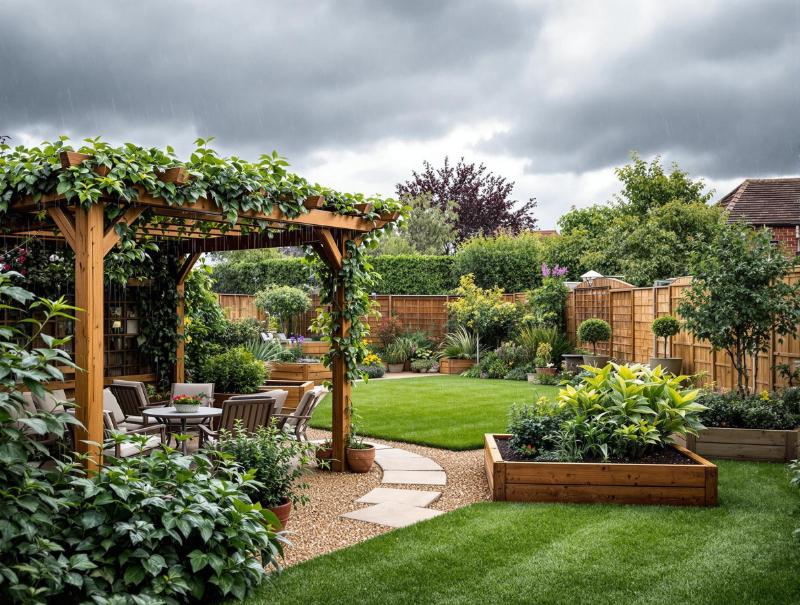Garden Weatherproofing Tips That Help to Make a Difference

British weather has a habit of keeping us on our toes. One week might bring sunshine, the next an unexpected storm or cold snap. That sort of unpredictability takes a toll on garden spaces, from the condition of the soil to the survival of certain plants.
Outdoor spaces deserve the same level of preparation as indoor ones, especially if they’re used year-round or sit close to essential parts of the home. Are you looking for ways to weatherproof your garden? If so, keep reading as these tips offer real ways to support your garden in London through seasonal challenges and protect it from damage, no matter what the forecast throws at it.
Sort Out Drainage Before Problems Set In
Patches of standing water or muddy corners after rainfall are signs of drainage issues. Allowing water to sit for long periods leads to root damage, lawn discolouration, and slippery surfaces. The sooner you address the drainage issue, the sooner you can help to keep your garden healthier and safer.
It’s easy to resolve; check where rainwater collects after a downpour. If you notice puddles forming around flower beds, paths, or the base of walls, make minor adjustments to these spaces to help. You could shift soil levels slightly or add gravel channels to help improve flow. Additionally, in the areas that are little more closer to your home home, you might want to look into a rain garden or water butt to divert excess water for future use.
Don’t forget about surfaces like patios and paths; they also need your attention. Blocked drains or poorly designed slopes cause overflow, pushing water where it’s not wanted. A simple clean-out of gutters and inspection of nearby pipework makes a noticeable difference.
Block Strong Winds with Smart Placement
Wind affects more than just delicate plants. It dries out soil, moves pots, and damages fences or outdoor furniture. While it’s impossible to control the weather, it’s possible to shape how it moves through the garden.
Use natural barriers to reduce exposure. Hedges and dense shrubs can create shelter when placed along open sides. Trellises with climbing plants provide coverage without taking up much room. In tighter spaces, garden screens offer quick solutions with minimal digging.
Planting arrangements also play a part. Taller plants should sit at the back of borders, where they are less exposed. Position heavier pots on sheltered patios, or secure them with brackets or weights if they’re likely to shift in storms.
Of course, a secure fence remains a top priority. Aside from providing privacy, a fence is a must if you have children or pets. Understandably, you will want to ensure it will not move, especially when the winds pick up. As such, check for any signs of loose panels or posts. If they need minor repairs, make them, as they will go a long way during high winds.
Check How Nearby Structures Affect the Garden
Sheds, greenhouses, fences, and garages all play a part in shaping the garden environment. Their condition affects everything from water flow to shade, and overlooking this can cause issues that repeat every season.
Roofs matter more than people expect. A damaged or poorly sealed garage roof allows rain to run off unintentionally. If that happens, you might notice pooling near flower beds, moss on paths, or increased damp near your home’s walls.
Those issues become more noticeable when the garage is close to planters or decking. Cracks or splits in old garage roofing lead to problems not just on the structure itself but also across the garden space.
If this keeps happening, it may be time to look into replacing your garage roof. A well-installed system offers better protection and directs water away correctly. This type of upgrade limits further damage and keeps neighbouring garden areas safer during storms. A trusted professional can help with safe and effective garage roof replacement that suits the structure and space available.
Choose Plants That Can Cope with Local Conditions
Some plants struggle to recover after long spells of rain or frost. Selecting species that suit the local climate reduces disappointment and saves on replacements.
Look for native perennials and hardy options known to survive across the UK. These plants often require less maintenance and bounce back better after cold spells. Lavender, ferns, sedums, and heucheras are dependable choices that work well in mixed borders.
The timing of planting matters too. Try planting hardy shrubs and trees in autumn to give them time to establish before harsher conditions. Keep mulch handy to protect roots during winter, especially for plants closer to paved areas where heat can reflect and cause stress.
Watering during dry spells remains important, even for tougher plants. Use a watering can or drip system early in the morning to avoid unnecessary evaporation.
Prepare the Ground for Seasonal Shifts
Soil quality changes throughout the year. It gets compacted in wet months, dries out fast during heatwaves, and loses nutrients with repeat planting. Giving it care once per season helps plants stay healthier and resist stress.
A garden fork helps break up compacted areas. Adding compost or leaf mould boosts nutrients while improving texture. Mix in some grit for heavier soils to improve drainage and prevent waterlogging.
Test the pH levels if growth seems slow or patchy. Slight adjustments with lime or sulphur can bring the soil into a better range for your plants. Keep organic matter topped up in beds and borders. That helps retain moisture and reduce the need for constant watering.
Don’t forget the edges. Paths, borders, and lawn edges need attention too. Clean up creeping weeds or grass and keep them clear so they don’t cause moisture build-up around fences or walls.
Inspect and Maintain Outdoor Items Regularly
Outdoor spaces rely on more than plants. Furniture, tools, and storage units affect how a garden looks and functions and how well it copes with the weather.
Cover furniture during wet or cold spells. Choose breathable covers to stop mould and mildew. Move lighter items to a secure place or anchor them with weights. Strong winds can lift tables and scatter planters without warning.
Greenhouses, sheds, and garages need seasonal checks. Look for warped panels, missing shingles, or weak seals. Regular inspections prevent water from getting inside and prevent rot from setting in.
Garage structures sometimes get overlooked. Damaged garage roofing lets in moisture causing lasting damage inside and nearby. Dealing with small repairs early avoids bigger bills later and helps maintain surrounding parts of the garden.
Keep Your Garden Strong Through Every Season
Preparation brings results. Every step taken to reduce weather impact makes the garden more enjoyable and less work over time. It’s about building long-term strength, not chasing short-term fixes.
Simple upgrades, better drainage, stronger fences, soil care, and timely repairs, all add up. Structure, layout, and materials each contribute to a healthier, more weather-ready space.
If structures like garages are affecting your outdoor area, take the time to assess them and consider expert options for replacement. It’s one of those decisions that has benefits beyond what’s immediately visible.
Take the pressure off next season’s storms. Get ahead with these weatherproofing tips and enjoy a garden that holds up better, looks good longer, and stays easier to maintain year-round.





